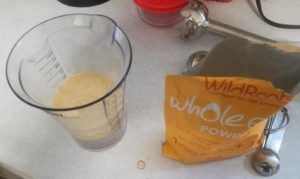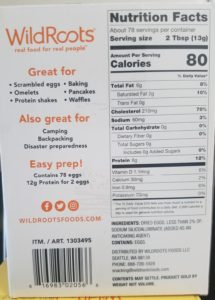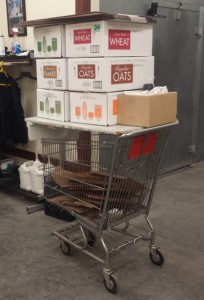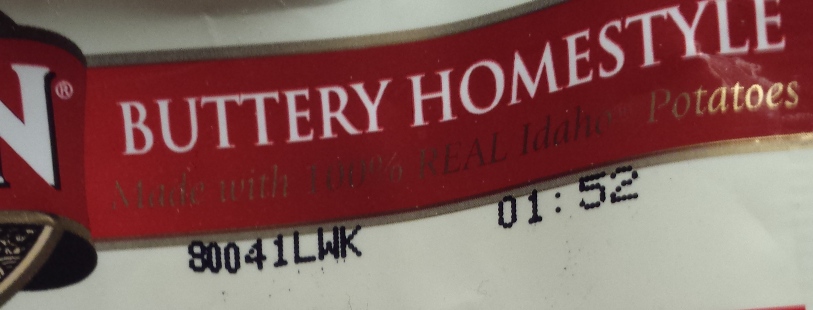I’ve never heard of anyone in the military who had to eat powdered eggs and had anything positive to say about them. Perhaps the military gets a lower grade of product…or perhaps military food preparation is abysmal.. or all of the above. My experience with powdered eggs has been okay. Theyre not “Ohmigod these are awesome!” but they aren’t “What the hell is this crap?” either. On a few occasions I have fed them to people without telling them what they were and no one said anything. I find them to be acceptable, and certainly a better alternative to no eggs. Anyway…. All powdered eggs seem to be extremely distasteful before cooking. You get this orange-colored thing that looks like pancake batter and smells like burnt cheese from a toaster oven. It isnt until you start cooking them that some sort of transformative process begins and they become more appealing.
All powdered eggs seem to be extremely distasteful before cooking. You get this orange-colored thing that looks like pancake batter and smells like burnt cheese from a toaster oven. It isnt until you start cooking them that some sort of transformative process begins and they become more appealing.  These eggs, branded as “WildRoots” and picked up at CostCo, were exactly like every other powdered egg product I’ve tried. Not bad, not great, but definitely a worthy addition to the food storage.
These eggs, branded as “WildRoots” and picked up at CostCo, were exactly like every other powdered egg product I’ve tried. Not bad, not great, but definitely a worthy addition to the food storage.  As mentioned a couple posts back, my local CostCo had them on closeout, marked down from $6.97 to $2.97 which is a stupidly good deal.
As mentioned a couple posts back, my local CostCo had them on closeout, marked down from $6.97 to $2.97 which is a stupidly good deal.
 For those of us who, at the moment, don’t have a backyard full of chickens but want to maintain a semblance of ‘normalcy’ when it comes to breakfast, and have some protein on hand, these would be an excellent choice. Canned bacon, dehydrated eggs, hash browns, biscuit/muffin mix, powdered milk, Tang, canned fruit, pancake mix, honey, and you’ve got a pretty decent breakfast with a shelf life of several years. After a long night of manning the barricades, chasing looters, and guarding the house, a breakfast like that would be rather welcome, I should imagine. In a slightly more realistic vein, these are an excellent choice for hunting cabins and other non-grid locations where store-bought eggs aren’t an option and you’re not around often enough to keep chickens.
For those of us who, at the moment, don’t have a backyard full of chickens but want to maintain a semblance of ‘normalcy’ when it comes to breakfast, and have some protein on hand, these would be an excellent choice. Canned bacon, dehydrated eggs, hash browns, biscuit/muffin mix, powdered milk, Tang, canned fruit, pancake mix, honey, and you’ve got a pretty decent breakfast with a shelf life of several years. After a long night of manning the barricades, chasing looters, and guarding the house, a breakfast like that would be rather welcome, I should imagine. In a slightly more realistic vein, these are an excellent choice for hunting cabins and other non-grid locations where store-bought eggs aren’t an option and you’re not around often enough to keep chickens.
They are packaged in a foil-ish paper pouch but I would vacuum seal this stuff up to be extra sure it is protected for long term. If you can’t find these at your local CostCo, here’s the nutritional and company info:
 Don’t get annoyed if you can’t find them at your local CostCo. It seems that powdered eggs are powdered eggs are powdered eggs… there doesn’t seem to be much difference between ones I’ve tried. Augason Farms sells #10 cans of powdered eggs and I’d bet they are identical to this stuff. Only major difference is packaging and CostCo’s remarkable discount.
Don’t get annoyed if you can’t find them at your local CostCo. It seems that powdered eggs are powdered eggs are powdered eggs… there doesn’t seem to be much difference between ones I’ve tried. Augason Farms sells #10 cans of powdered eggs and I’d bet they are identical to this stuff. Only major difference is packaging and CostCo’s remarkable discount.
At $2.97, it’s worth buying a box just for the experimental value.






